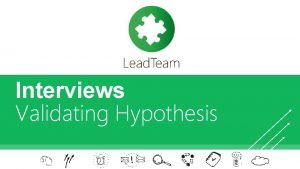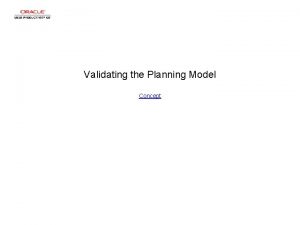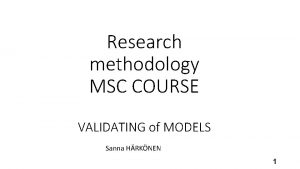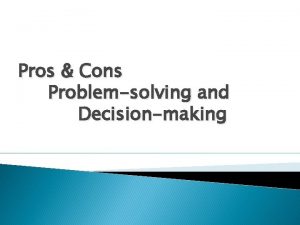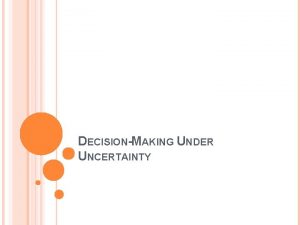Designing and Validating a Methodology for Shared Decisionmaking
















- Slides: 16

Designing and Validating a Methodology for Shared Decision-making: A Non-Pharmacological Approach to the Management of Chronic Pain UWS MCS Symposium Abbie Mc. Guire, Ph. D Researcher

Project Aim • This project aims to define and validate in practice a suite of development and implementation processes and tools to support the creation of aids for shared decision-making. • The project will use the development of a decision aid for the non-pharmacological treatment of chronic pain as a test case for designing the toolkit.

What is Shared Decision-making? • Shared decision-making (SDM) is a practice in which patients and clinicians work in partnership to choose treatments, management packages, support packages, or tests based on the patient’s informed preferences and clinical evidence. • SDM involves the availability of evidence-based information concerning uncertainties, outcomes and options, together with counselling for decision support and a system for implementing and recording patients’ informed preferences (Coulter & Collins, 2011).

When Can SDM Be Utilised? • Shared decision-making is suitable for use in making decisions regarding: taking medication, undergoing a diagnostic test or screening, attempting a change in lifestyle, undergoing a surgical or medical procedure, partaking in a psychological intervention or self-management education programme (Coulter & Collins, 2011).


Why use SDM? • The benefits of shared decision-making are recognized within national healthcare strategies as supporting self-management (independence), promoting person-centred care, and preventing over-use of medical interventions.

Decision Aids • Patient decision aids (DA) are tools that help people become involved in decision making by making explicit the decision that needs to be made, providing information about the options and outcomes, and by clarifying personal values. They are designed to complement, rather than replace, counselling from a health practitioner.


Gap in Knowledge • Regardless of the extensive interest in SDM, the utilisation of SDM and decision aids within the UK has been inconsistent. • The greatest difficulty currently is to formulate efficient development and implementation processes and tools methods to aid SDM and guarantee that it is implemented in standard clinical practice. Implementing SDM into behaviours and skills, systems, workforce attitudes and processes is a difficulty.

Original Contribution to Knowledge • My project will look at the valuable lessons learned from pilot projects identified from the literature review and collate this information to help close the gap in the literature of how to define and validate in practice a suite of development and implementation processes and tools to support the creation of aids for shared decisionmaking to facilitate the successful implementation and standard practice of SDM and DA within the NHS.

Why Chronic Pain? • The project will use the development of a decision aid which focuses primarily on the non-pharmacological treatment of chronic pain as a test case for designing the toolkit. Chronic pain has been chosen as the test case, as, in addition to having a considerable impact on the quality of life for many individuals and their families in Scotland, the condition also has a substantial impact on society, the healthcare services and on economic costs.

Original Contribution to Knowledge • Therefore, in an attempt to reduce these costs and impacts, the shared decision-making aid will focus primarily on the non-pharmacological management of chronic pain, which is currently a high priority area for Scotland since the current pathway of care in the NHS and the focus of decision aids for patients with chronic pain is very much pharmacologically based.

Method of Approach • The methodology for designing and implementing the shared decision-making aid for chronic pain will build on existing best practice. This will be identified through literature review and gathering examples of current practice through surveying NHS Boards.

Development Process • Interviewing or holding focus groups with patients and healthcare professionals to find out what options patients and practitioners need to discuss, use their personal experience on the risks and benefits of treatments options for chronic pain and ask their opinion on shared decision making and the non-pharmacological treatment of chronic pain. I will then analyse the data using thematic analysis to categorise the different responses under different themes which may correspond to themes also identified in my literature review.

Evaluating impact of SDA on quality of decisions and outcomes for patients and professionals. • Use validated tools (Scholl et al. , 2011) for measuring quality of decisions to determine whether chronic pain patients and their healthcare professionals are reaching higher quality decisions, based on patients’ preferences, which improve patient comfort in the choices made as a result of the final decision aid/toolkit. Also gather basic measures about usage and patient and professional reactions to the decision aid through survey/questionnaire

The Final Aim • The ultimate aim will be to scale-up the methodology for wider use in Scotland’s health and social care.
 Survey of household economics and decisionmaking
Survey of household economics and decisionmaking Methodology for designing controls and substantive tests
Methodology for designing controls and substantive tests Subtitle integration
Subtitle integration Formuö
Formuö Novell typiska drag
Novell typiska drag Tack för att ni lyssnade bild
Tack för att ni lyssnade bild Vad står k.r.å.k.a.n för
Vad står k.r.å.k.a.n för Varför kallas perioden 1918-1939 för mellankrigstiden
Varför kallas perioden 1918-1939 för mellankrigstiden En lathund för arbete med kontinuitetshantering
En lathund för arbete med kontinuitetshantering Kassaregister ideell förening
Kassaregister ideell förening Personlig tidbok fylla i
Personlig tidbok fylla i Sura för anatom
Sura för anatom Densitet vatten
Densitet vatten Datorkunskap för nybörjare
Datorkunskap för nybörjare Tack för att ni lyssnade bild
Tack för att ni lyssnade bild Debattinlägg mall
Debattinlägg mall För och nackdelar med firo
För och nackdelar med firo


